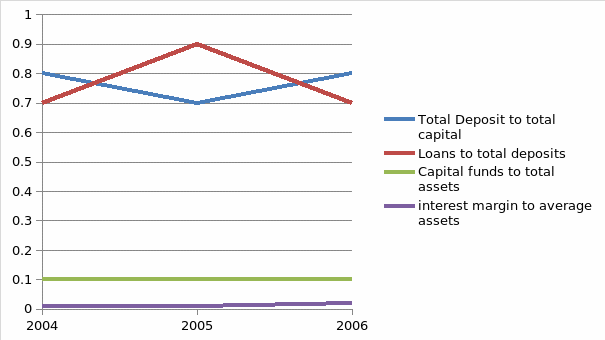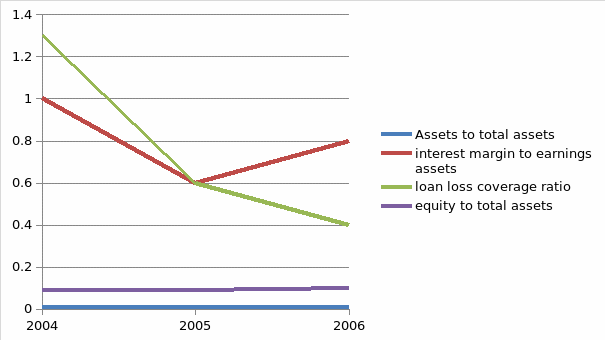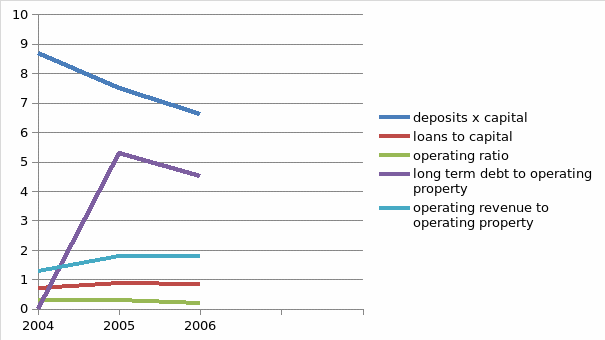Abstract
This report is on financial analysis of Fransi bank of Saudi Arabia, a leading financial institution in the country. The financial analysis reveals the financial performance of the bank and the key factors that help the bank to be a leading organization in the industry. The bank has pursued strategies that have ensured profitability is maintained.
The ratio analysis carried out shows that the bank is on its way to success because it has shown slight growth in profitability regardless the current financial crisis. The liquidity of the firm declined although the decrease in the liquidity was minimal. The liquidity ratios showed a downward trend although this may be due to the financial crisis that has hit this country. Looking at the solvency ratios on notes that the companies’ solvency is in question since the capital structure of the bank is financed mostly by debt. Long term debt is two fold the value of equity and it is showing an upward trend. Although this problem the organization is seeing an upward trend in profitability. The profitability margin increased regardless the financial crisis as well as the return assets.
Introduction
This report is aimed at measuring the general performance of the Fransi bank. The ratios would help users to get an in- depth understanding of Fransi bank’s profitability, financial stability and efficiency with which it is utilizing its assets to generate sales revenue. For the management, their objective would be on how to improve on poor areas and maintain good performance. Its intended users are: the management of the bank, customers, employees and the government, who would use it for taxation purposes. The sources of the data used have been the published financial statements i.e. the Profit and loss accounts and the balance sheets of the past three years.
Saudi Banking Industry Fundamentals
Saudi banking industry has many key variables than influences its operations. The banks in Saudi Arabia have seen and maintained growth even during this period of economic hardships. The banks in Saudi Arabia have focused on investing in technology for the purpose of improving service delivery to the people. The baking industry in Saudi Arabia have engaged in various operations which assists them to grow. Some of the services that are offered by the Saudi banking industry include retail banking, Islamic banking, private banking and golden service, corporate banking, offshore banking , asset management services and many services that assist the bank to grow. The main variable that has made this bank successful with little effects from global financial crisis is the idea of Islamic banking.
Islamic banking is where the banks assist customers to make investments using sharia law. In Islamic banking financial services are competitively priced and they do not charge interest. A customer who wishes to do Islamic banking will need to open Islamic account with any bank in Saudi Arabia. The basic principle of Islamic banking is the absence of interest in lending and borrowing, contrast to the conventional banking, which operates on giving and taking interest. Islamic banking follows Shariah the Islamic law which prohibits taking or giving interest, or doing certain businesses not permitted by the religion. Modern financial principles and rules are not followed in Islamic banking. Islamic banking does not invest in riskier assets and also the derivative roots are not considered for investing. However Islam does not prohibit its believers from economical well being. For economical well being business needs to be developed. To develop Business, funding is required. But instead of taking the interest the Islamic banking takes a profit of what the business is earned, a share of the profit, not interest. Riskier investments or business are not funded thus reduces the risk of the investment these banks are made. In the current recession many financial institutions all over the world has become bankrupt but Islamic banks survived this economic slowdown.
Ratio Analysis
In overall, the ratios of the company are in good shape with a few exceptions where its ratios were less than the industries’ average ratios. Fransi bank had great results in its market-based ratios compared to the industry, and its gross profit margin was almost double the industries. Its liquidity ratios were less than the industry’s results. For customers, this would not be a good sign because they typically look for high current ratios, but as a shareholder it is good that Fransi bank has a lower current ratio than the industry’s average current ratio. Fransi bank quick ratio is much lower than the industry’s average, which is not great because they may not have enough resources that can be liquidated to cover short-term obligations.
The usefulness of ratios is ultimately dependant on their intelligent and skillful interpretation. Insight into the financial situation of a company will quickly place its condition in perspective. The critical areas in any profit or non-profit organization can be summed up as follows:
- Scanning and using funds
- Planning for securing and using funds
- Controlling expenditure
- Reporting all transactions and results to appropriate parties
Facts can be gathered and tentative conclusions can be drawn in the initial scanning of operations. Later, analyzing can provide information and understanding considerable depth. A ratio analysis measures how a company is doing in comparison with past years and its competitors in the industry.
The financial statements of a firm offer abundant information about the present position and also reveal the results of operations over time. The details of cash, receivables, inventories and corresponding liabilities are provided by the balance sheet. The job of the internal analyst is to make “make the figures talk.” Suitable explanations and notes have to be given at the end of every financial statement so that the reader can get an idea of it in an instant.
Keeping in view the above discussions regarding the category of users, financial ratios fall into three groups as follows: Liquidity ratios, Profitability or efficiency ratios, Ownership ratios, Earnings ratios, Dividend ratios and Leverage ratios. All the above mentioned categories of ratios are discussed in detail as under.
Analysis
Average total deposits to average total capital of the bank was unstable because it came down then went up. This means the deposits had gone down then it went up. This led to the increase in loans, at a faster rate than deposits. Because in the year 2005 average loans to average total deposits had a higher ratio as compared to two years 2006 and 2006.
The bank experienced a faster rise in deposits than in capital. The rise on deposits caused the increase in capital. It also led to the increase in loans which was faster than deposits thus having an effect of everything increasing. Capital to total assets decreased due to the fact that deposits were increasing. At the same time interest margin to average total assets decreased and this is a sign of reduced profitability of the bank.
From the below graph It can be seen that total deposits to total capital shows a different trend as compared to loans to total deposits. Total deposits to total capital shows a fluctuation but a downward fluctuation while loans to total deposits shows a fluctuation of upward trend. This is completely opposite of each other because when loans increase it reduces capital if the deposit were not coming in at the same rate.

Earnings to total assets increased indicating that the management was using the assets of the banks efficiently to generate profit at the same time interest to earnings increased. This is a show of increased profitability of the firm. Equity to total assets went up which is an increased guard against risk which will be brought by debts. Loan loss coverage ratio increased in the two years meaning that it increased the level of protection of loans. Loan to debt deposit also went up which is a show that the risk for the business increased. Lastly deposit times capital also increased for the three years which is a show that the return to the shareholders may be improving.
Operating revenue to operating property went up which is a sign of improved profitability. The operating ratio decreased from 30% in the year 2004 to 20 % in 2006 which is a clear show of improved profitability. There is also an increased in long term debt to operating property which is a clear indication of an increase in risk in the operations of the bank.

From the above graph it can be noted that earnings assets to total assets was having a straight line trend meaning there was little change in this ratio. However interest margin to average earnings showed a fluctuation in its trend the figure fell from 1.0 to o.6 before going up to 0.8. This kind of trend shows that the bank is unstable in generating revenue which will be used to pay interest that is incurred. This ratio is a liquidity ratio and it has a great impact on the lenders of finance to the bank. Loans loss coverage ratio showed a downward trend because the decline in the ratio indicates that the bank became efficient in evaluating the credit worthiness of customers.
Total interest income decreased between 2004 and 2005 before increasing between 2005 and 2006. Total interest expense decreased between 2004 and 2005 before increasing slightly between 2004 and 2005. Provisions for loan increased between 2004 and 2005 but decreased from 2004 to 2005. Total fees and other income showed an upward trend between the three years the same case applies to general and administrative expenses. Total other expenses showed a fluctuation in its change going down between 2004 and 2005 and increasing substantially between 2005 and 2006. The net result is that the revenues increased substantially between the three years.

Saudi banking industry and bank risk
A bank is any financial institution whose main activity is to carry out business as a payment agent and also borrow and lend out money. However, with time the banks have expanded their operations and now they are engaged in a wide range of activities. For instance Fransi Bank is a key players in the Saudi financial market and provide financial services like investment funds. The Fransi bank is very important in an economy of the country. Below are key functions which the Fransi bank plays:
- Issue of money: the bank issue money in form of bank notes as well as current accounts, in accordance to cheque or even an order of payment from the customer. The claims made on the bank can be used as money since they are negotiable or repayable when demanded. Thus, they are valued in according to they value and can be effectively be transferred by simply delivering the cheque to the payee or the bank or cashing it.
- Consolidating and settlement of payments: banks perform activities of a collecting agent and also a paying agent for their client. At the same time, the bank takes part in inter-bank clearing as well as settlement arrangements to collect, then present or be presented with, and make payments according to instructions. This assists banks to spend less on reserves withheld for arrangement of payments, because internal and external payments balance each other. At the same time it allows payments to flow between different geographical regions to balance, thus reduces the expenses of making payments among different geographical areas.
- Credit intermediation: The banks borrow and also lend back using their own accounts thus acting as middle men.
- Credit quality improvement: banks lend out cash to regular commercial as well as personal borrowers; however, they are high class borrowers themselves.
- Maturity transformation: like other banks anywhere in the world banks in Saudi Arabia use money deposited to issue loans to customers. They are able to do this because they invest in long term investments and are able at the same time to borrow from various sources since there are better borrowers.
Risks involved in the banks
Banks are susceptible to serious types of risk which when the risks occur at times may result in bank crisis. These risks include:
- Liquidity risk: this is the danger of depositors requesting to withdraw their money beyond available liquidity amount.
- Credit risk: the danger of those owing the bank money to fail paying bank, this may result in the bank collapsing with all the money from all those who put their money in the bank.
- Interest rate risk: this is the danger of the bank becoming unprofitable when high interest rates forces the bank to pay high amounts on what is deposited while receiving less interest from the loans it has lent out.
- Pool of people that they target:- While initial banks targeted the rich and middle class people as their key customer, high competition and changes in he industry has made banks to come down and target every individual even those previous considered as not valuable as customers.
The biggest concern in the financial sector has been the high number of financial institutions which have been collapsing due to failing to recover their dates and thus balance their operations. The way the financial assets portfolio are being management also remains a major challenge that the financial institutions have continued to undergo from last year to the present moment.
Loans are the main asset of banks, and other financial asset class, however, when this key asset becomes suspect, the very basis of a bank is upset to the bank to its very center, and this has been the situation over the past year. In addition the past year saw a decline in assert quality in many financial institutions. This can be attributed to the laxity in many banks of the previous success they enjoyed in earlier years.
Recommendation
In order to achieve better future results, better or close to industrial average, the firm needs to cut down its operating expenses. This would considerably improve the profitability ratios. They also have to review their policy on capital management and keep optimal levels of various items of current assets. This would improve the firm’s liquidity position. In order to improve the return on owner’s equity ratio, the management should invest in viable projects that would yield positive NPV’s.This has the effect of maximizing their wealth. To improve on the financial ratios, the firm would ensure that it has more liquid assets and also resort to internal sources of finance as opposed to external ones.
Based on the debt ratio, and if the bank is to finance the any investment it should be through internal borrowings (equity), then it would be advisable to do so. This is because Fransi bank’s debt management is not efficient as shown by the declining trends of debt. This is because additional borrowings would adversely affect the Bank’s balance sheet position; they should withdraw the expansion plan.
References
Cohen, Jerome B.,Edward D. Zinbarg, and Arthur Zeikel, Investment Analysist and Portfolio management, 5th ed. Homewood, IL; Richard D.Irwin, 1987.
Davis, H.Z,. and Y.C Peles , measuring equilibrating forces of financial ratios , the accounting review ( 1993).
Largay, James A III and Clyde P. Stickney,(1980); cash flows, ratio analysis and the W.T Grant Bankruptcy, financial analysis journal (1980).
Saunders, Anthony,(1997); financial institution management: a modern prospective 2nd ed. (Chicago, IL: Richard D Irwin).